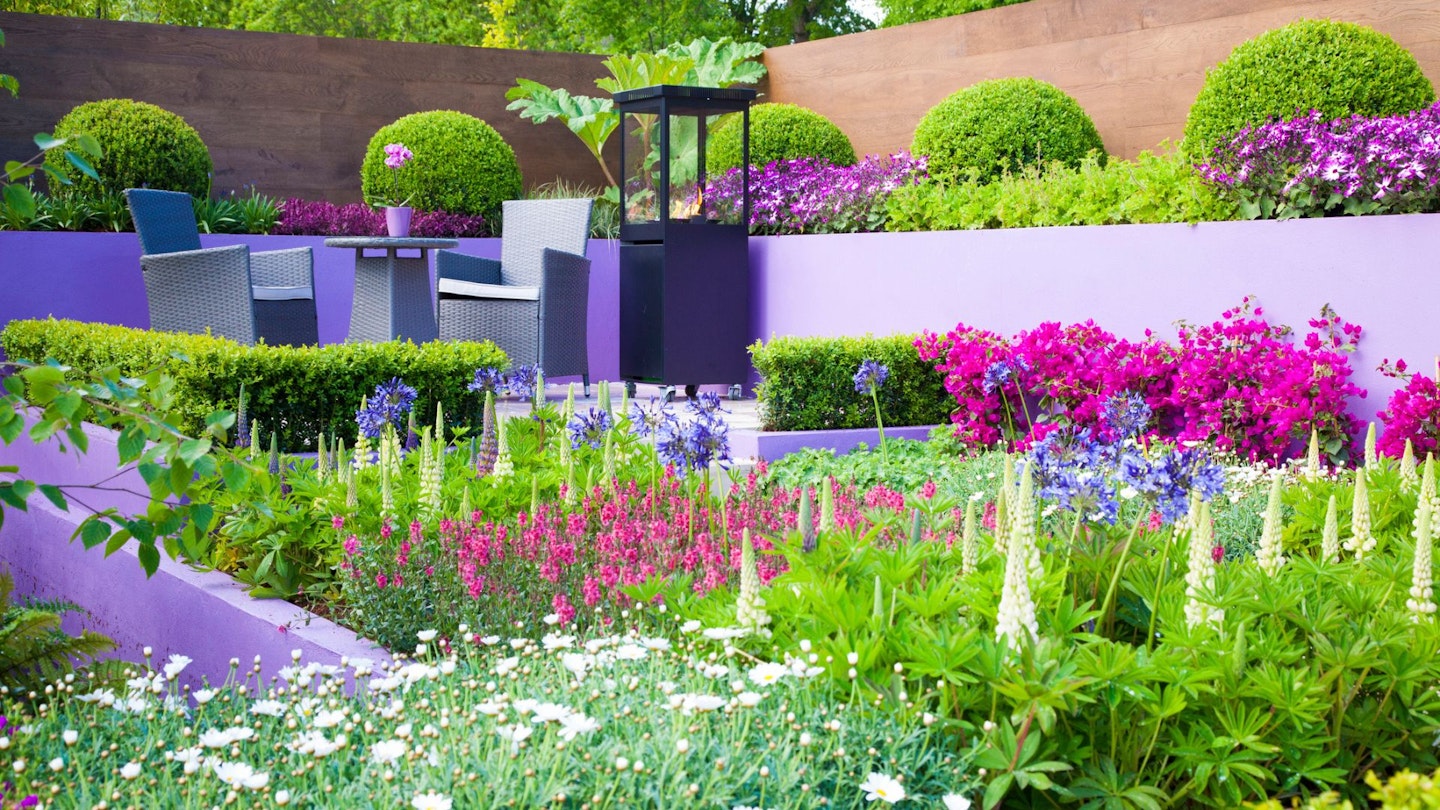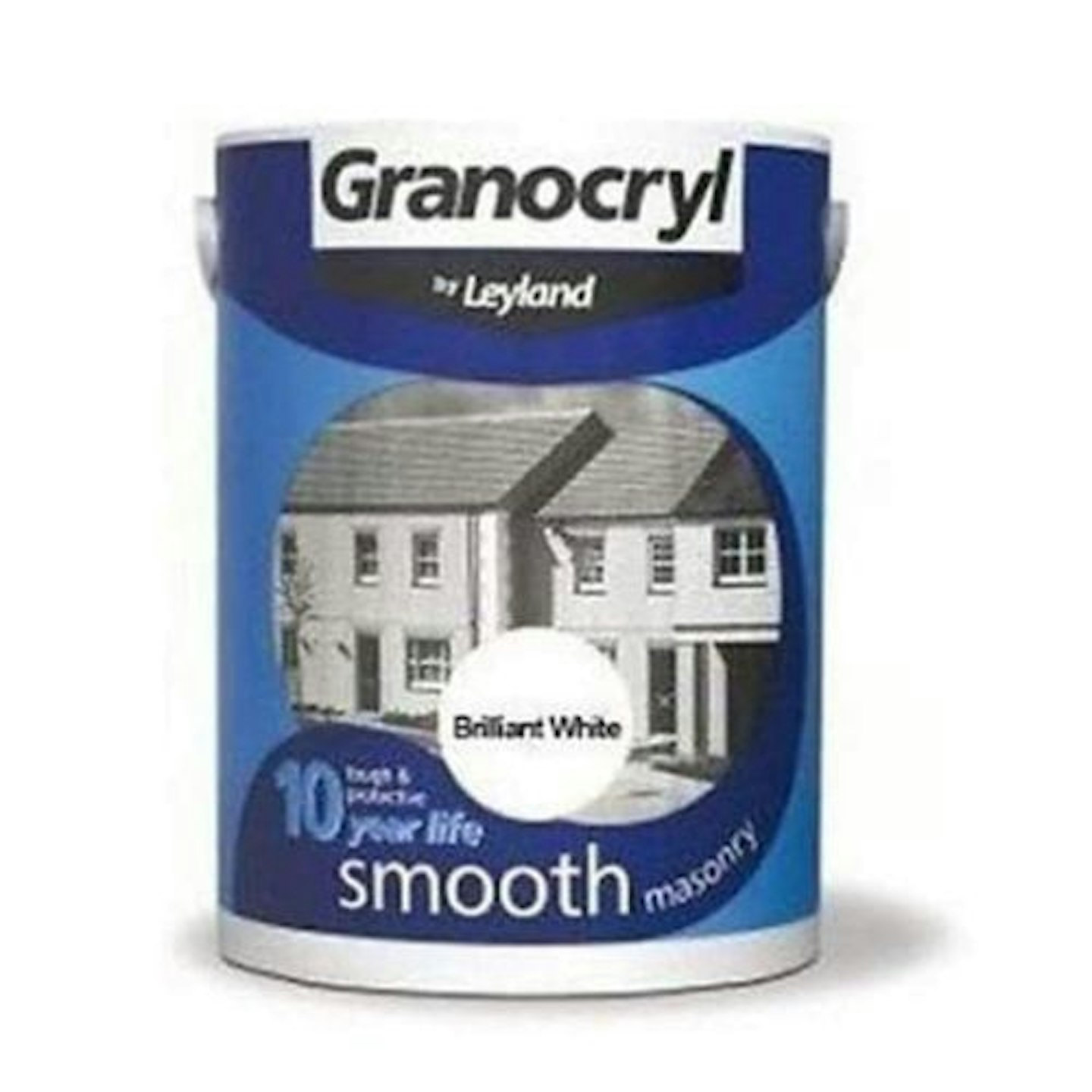Just like garden accessories, a fresh lick of paint can be a relatively instant and inexpensive way of transforming your garden. Not only that but there are some superb products that provide long-term protection and can withstand all weather for years to come. If you're reviving brickwork or adding a touch of personality to your patio - Modern Gardens has got you covered.
Using the right paint, you can improve grubby, ugly or boring walls to transform the look of your whole garden. But who says walls have to be just one colour? Create a feature wall by marking out and masking off each section of your design, making sure each colour is dry before doing the next.
You could recreate a white and blue exterior inspired by your Greek holiday or take inspiration from summery ice cream hues. Whether it's giddy green, fuchsia pink or chalky blue, you can use dramatic and pleasing tones to soften hardscaping and help to make a space feel bigger. Plus, you'll be bang on trend if you accessorise with colourful garden décor.
Best outdoor wall paint at a glance:
• Editor's choice: Ronseal Garden Paint Purple Berry, 2.5L
• Best colour masonry paint: Farrow and Ball Exterior Masonry Cook's Blue, 5L
• Best smooth masonry paint: Armstead Trade Smooth Masonry, 5L
• Best masonry paint for extreme weather: Dulux Trade Weathershield Maximum Exposure Smooth Masonry Paint, 5L
How you design your garden wall is up to you, but with the best outdoor wall paint, you know it'll last. Jump to the FAQs at the end of this article for guidance on what to look for and how to prepare masonry and brickwork for paint. In addition, we'll round up a few more common paint and painting accessories queries, such as how to dispose of paint tins.
Best outdoor wall paint
Editor's choice
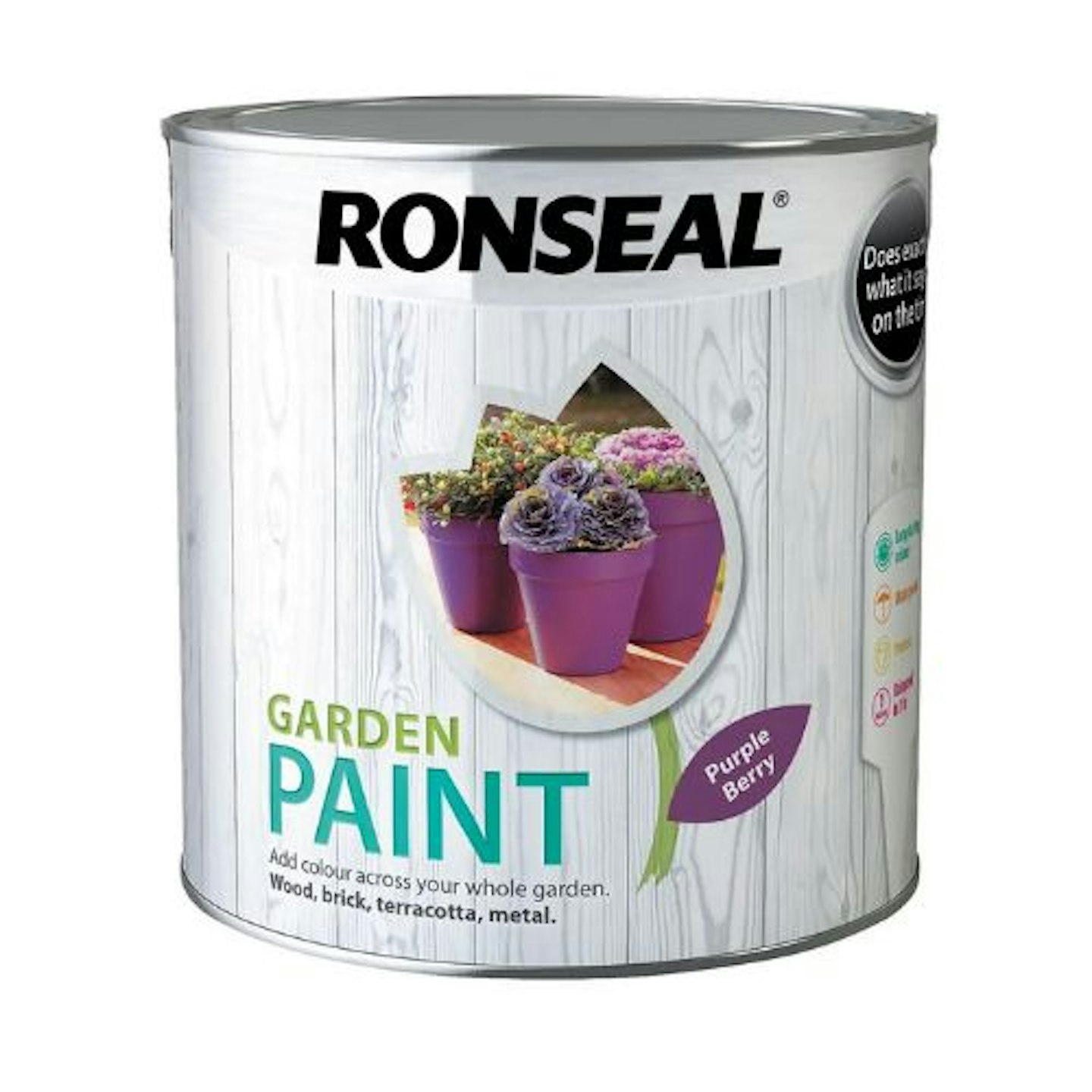
www.homebase.co.uk
For a rainbow of bold shades, choose Ronseal Garden Paint. The purple berry colour is bold, uplifting and versatile too. Ronseal can be applied to wood, brick, terracotta and metal. Give an old metal bistro set a refresh for summer or create a feature wall - it's up to you. Additionally, it's a water-based paint that resists fading, cracking and peeling. And this tin of loveliness will waterproof wood, provide colour and protect surfaces for at least five years.
Pros
- Enormous range of modern colours
- Waterproof outdoor surfaces
- Versatile
- Good price
Cons
- No customer reviews
| Size: | 2.5L or 250ml |
| Coverage: | 12 sq m per litre |
| Drying time: | Rainproof in one hour |
- 5 year colour protection on wood
Best colour masonry paint
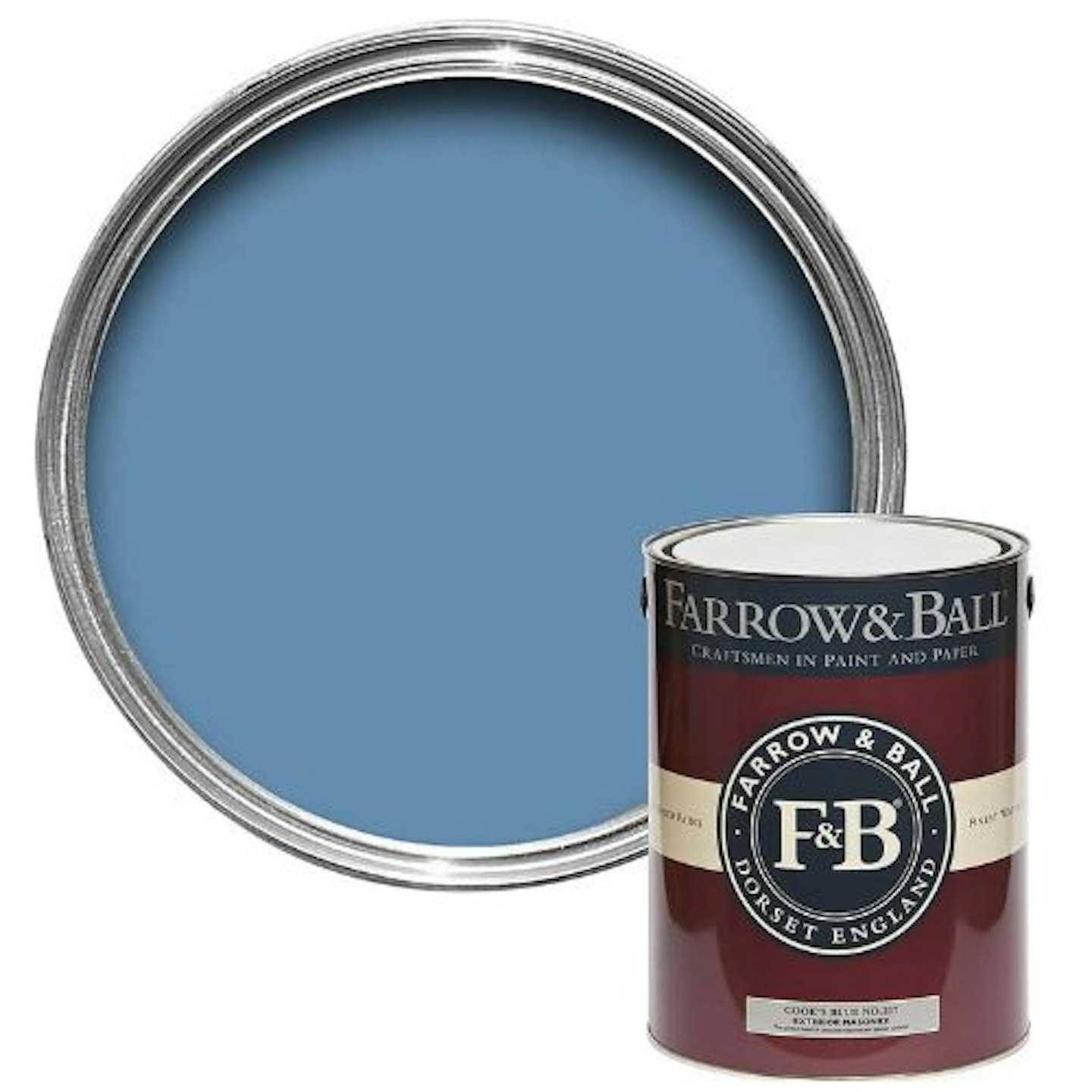
www.homebase.co.uk
A masonry wall painted bright blue will make your plants stand out. Farrow and Ball Exterior Masonry Cook's Blue has a very flat matt finish that adds a cheery warmth and provides a fresh contrast to foliage. The blue pigment was inspired by the cook's closet at Calke Abbey. It's said that this hue was used in kitchens to deter flies. This is a highly breathable, water-resistant and mould-resistant exterior masonry paint. It's suitable for exterior brick, render and concrete. This durable paint resists flaking, peeling, and fading for up to 15 years. It is recommended that you apply a primer first.
Pros
- Lasts up to 15 years
- High quality
- Wonderfully evocative range of colours
Cons
- Need to apply a primer
| Suitable for: | Exterior brick, render and concrete |
| Coverage per litre: | 8m2 |
| Number of coats: | 2 |
| Coverage per tin: | 40m2 |
| Finish: | Matt |
- Super-matt, long-lasting finish for exterior walls.
- Water-resistant formula protects walls
Best smooth masonry paint
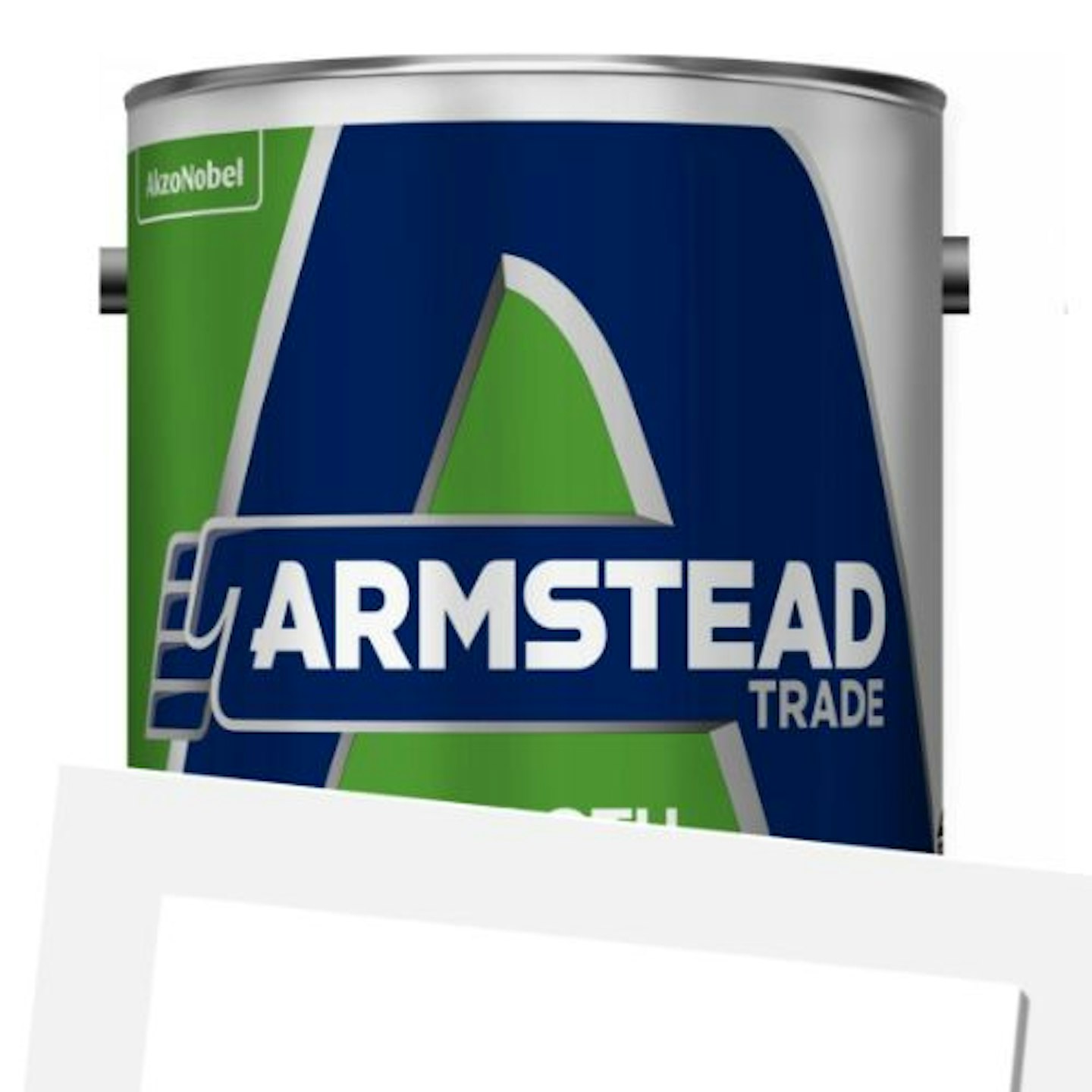
www.brewers.co.uk
Armstead Trade Smooth Masonry can be thinned with water and applied by brush, roller, airless spray or HVLP Spray. This professional quality, smooth exterior emulsion paint is touch dry in 1-2 hours and recoatable after 2-4 hours. It's loved by professionals for its ease of application. You'll be over the rainbow to know that there's a huge range of colours in this range of quality water-based paint.
Pros
- Versatile methods of application
- Long-lasting protection for masonry
- Buy in large quantities
Cons
- Need to apply more than one coat
| Size: | 5L |
| Application methods: | Airless spray, brush, roller |
| Coverage: | Up to 12sq/m per litre |
| Drying time: | 1-4 hours |
| Lifespan: | Up to 15 years |
| Finish: | Matt |
- Low V.O.C.
Best masonry paint for extreme weather

www.duluxdecoratorcentre.co.uk
For a modern, naturally crisp look, this Dulux Trade Weathershield Maximum Exposure Smooth Masonry Paint will give you brilliant white in a fresh tone. Dulux claims that this masonry paint is five times more flexible than conventional masonry paints. It's shower-resistant in just 15 minutes and provides superior protection against mould and algae. In addition, this smooth masonry paint is salt/chemical spray resistant and has anti-fade technology - great if you live by the seaside. It's formulated with harsh weather in mind and can cover hairline cracks and prevent subsequent cracking or flaking.
Pros
- Excellent durability
- Suitable for harsh environments
- Excellent opacity and adhesion
Cons
- None
| Drying time: | 2-4 hours |
| Touch dry: | 30 minutes |
| Coverage: | Up to 14sq/m per litre |
| Number of coats: | 2 |
| Finish: | Smooth |
- Application down to 7 degrees Celsius
Most bold exterior paint
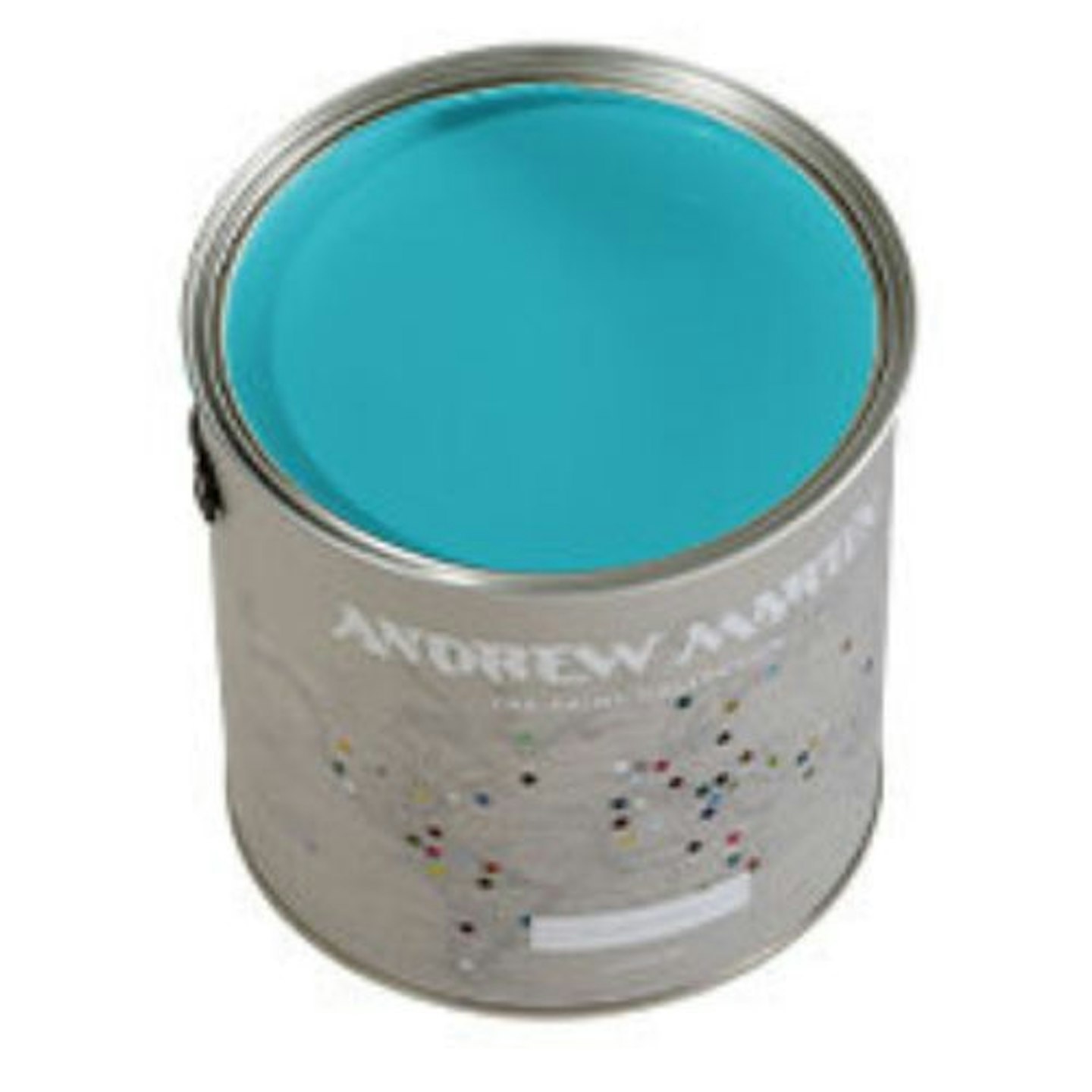
www.designerpaint.com
Get a touch of the Med with the wonderfully named Carnival Headdress by Andrew Martin. This satin masonry paint has a lustrous, velvety finish. It's also available in low sheen, gloss or matt and can be used inside and outside. Its versatility doesn't end there; this paint can be applied to masonry, walls and metal. With a re-coat time of less than one hour, you can build up a bold pop of colour as a nice little weekend garden project.
Pros
- Versatile - can be used inside and out
- Vibrant colour
- Can be used on walls, woodwork, metalwork
Cons
- Contains VOCs which can be harmful to health - wear a mask when applying
| Size: | 1L (2.5L and test pot available) |
| Finish: | Satin also choose from low sheen, gloss or matt |
| Coverage: | 20m2 |
| Sheen level: | 20 per cent |
- VOC Content: 25g/l
Best traditional outdoor paint
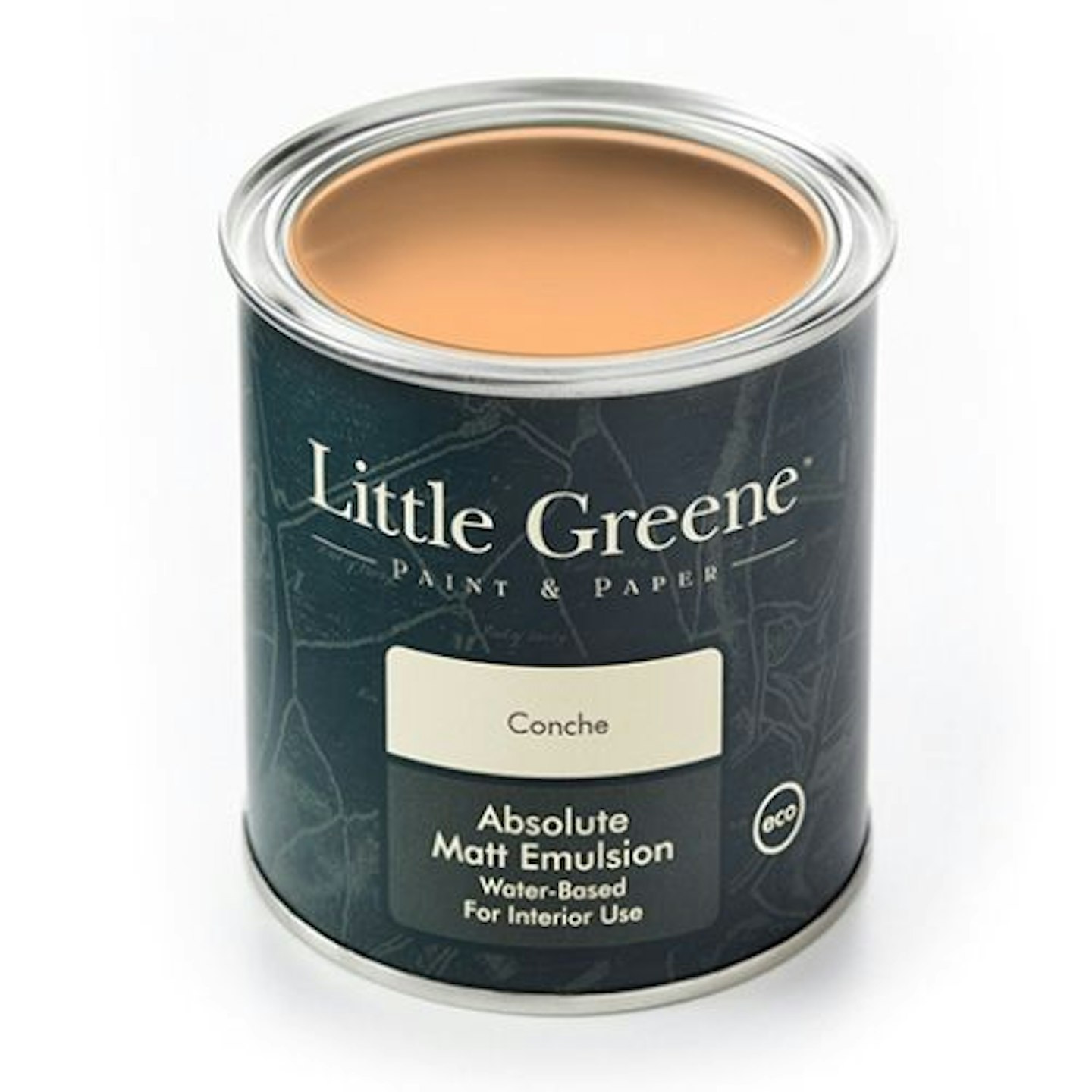
www.littlegreene.com
Add warmth with this rich apricot shade. Timeless Look Little Greene Limewash in Conche is hand-crafted in the UK by Little Greene, who is in association with the National Trust. Limewash is a water-based exterior paint that's ideal for applying to traditional building materials. It's not suitable for non-porous stones such as granite and slate. Limewash has a low sheen of less than 5 per cent, which provides a breathable finish. You need to leave 24 hours between applying each coat of limewash.
Pros
- An enormous range of colours and finishes available
- Available in lots of types of exterior paint
Cons
- You need to apply four coats to get good coverage
| Size: | 5L (sample pot available) |
| Finishes available: | Limewash, Traditional Oil Gloss, Intelligent Gloss, Absolute Matt Emulsion, Intelligent Eggshell, Intelligent Matt Emulsion, Intelligent Masonry Paint |
| Touch dry: | 1 hour |
- Virtually zero VOCs
Best value masonry paint
For excellent covering power at a budget price, Leyland 303139 Granocryl Smooth Masonry Paint is a great choice. Magic on masonry and outdoor surfaces in general, this is a must-have tin for your paint collection in the shed. It can be used without any primer or sealant and its water-based formulation allows brickwork to breathe. There's a lack of colours and finishes, but as a good all-around value paint this Leyland smooth masonry paint is durable and will give any surface a fast uplift.
Customer review: "Really nice to apply, good texture, good coverage. I have used it on concrete slabs, wood and even metal. It sticks well and dries quickly. Excellent for what I wanted to do. And being able to wash the brushes out with water is just a bonus.
Pros
- Hardwearing
- Moisture-resistant
- Breathable
- Water-based
Cons
- Dries to a matt finish
| Size: | 2.5L (5L available) |
| Finish: | Smooth, Textured |
| Coverage: | 10 sq m per litre |
| Colour: | Brilliant White or Black |
- For use on exterior brickwork, concrete, roughcast rendering
Best masonry paint for a chalky finish
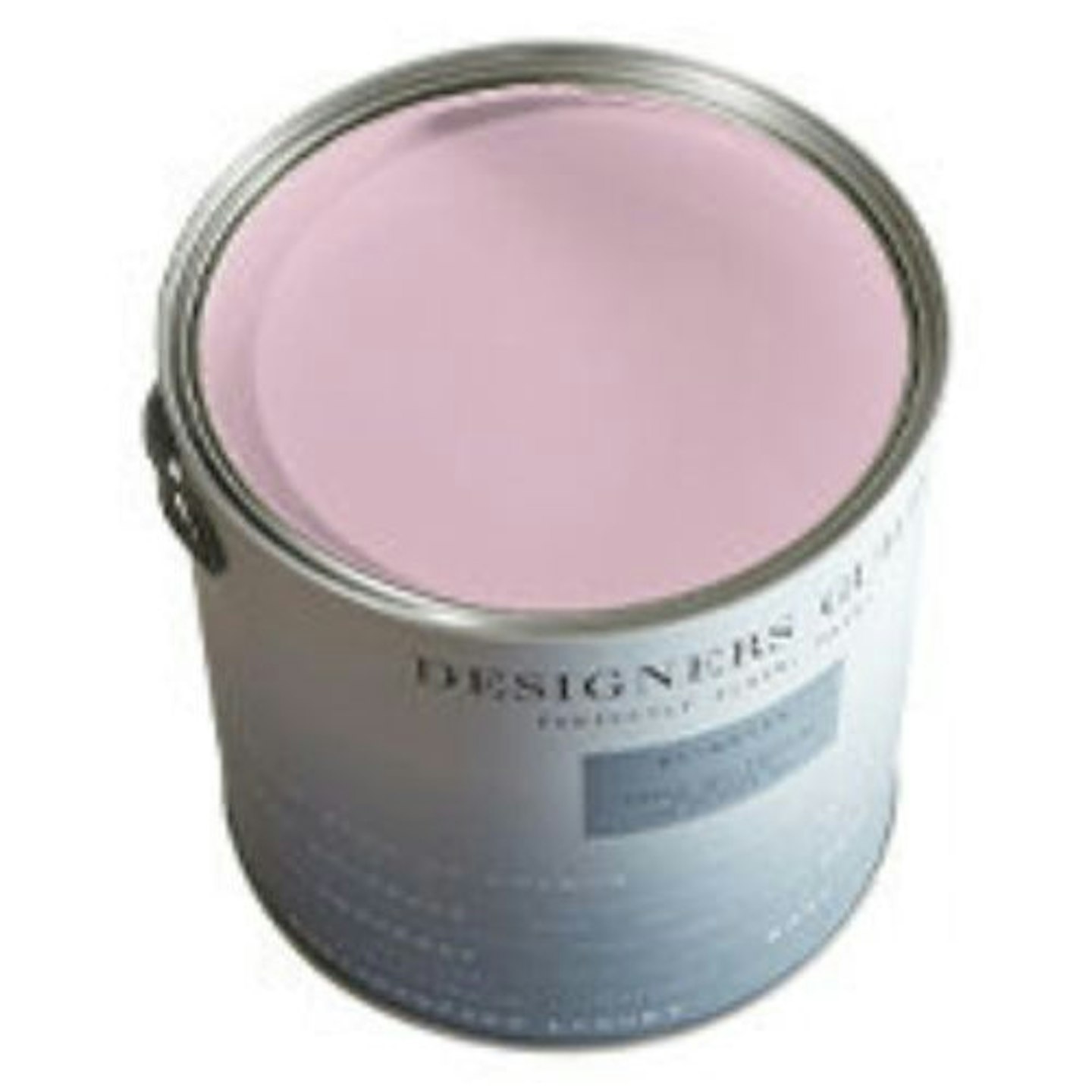
www.designerpaint.com
Get pretty in pink with this beautiful chalky finish masonry paint. Perfect Masonry Paint Designers Guild Dianthus Pink is practical too: it's weatherproof and mildew and fade resistant. There are 156 beautiful contemporary colours in the Designers Guild range. Also, this paint collection is available in four finishes, Perfect Matt Emulsion, Perfect Eggshell, Perfect Floor Paint and Perfect Masonry Paint. It's recommended that you try a tester pot first as the colour may look different, depending on the surface.
Pros
- On-trend colour
- Huge range of colours and finishes
Cons
- Colour may come out differently depending on the surface
| Size: | 2.5, 5L or test pot |
| Finish: | Perfect Masonry Paint, Perfect Matt Emulsion, Perfect Eggshell, Perfect Floor Paint |
| Coverage: | 75 sq m |
- Designers Guild paints aim meet the highest expectations of coverage and depth of colour
Best outdoor paint for a base coat
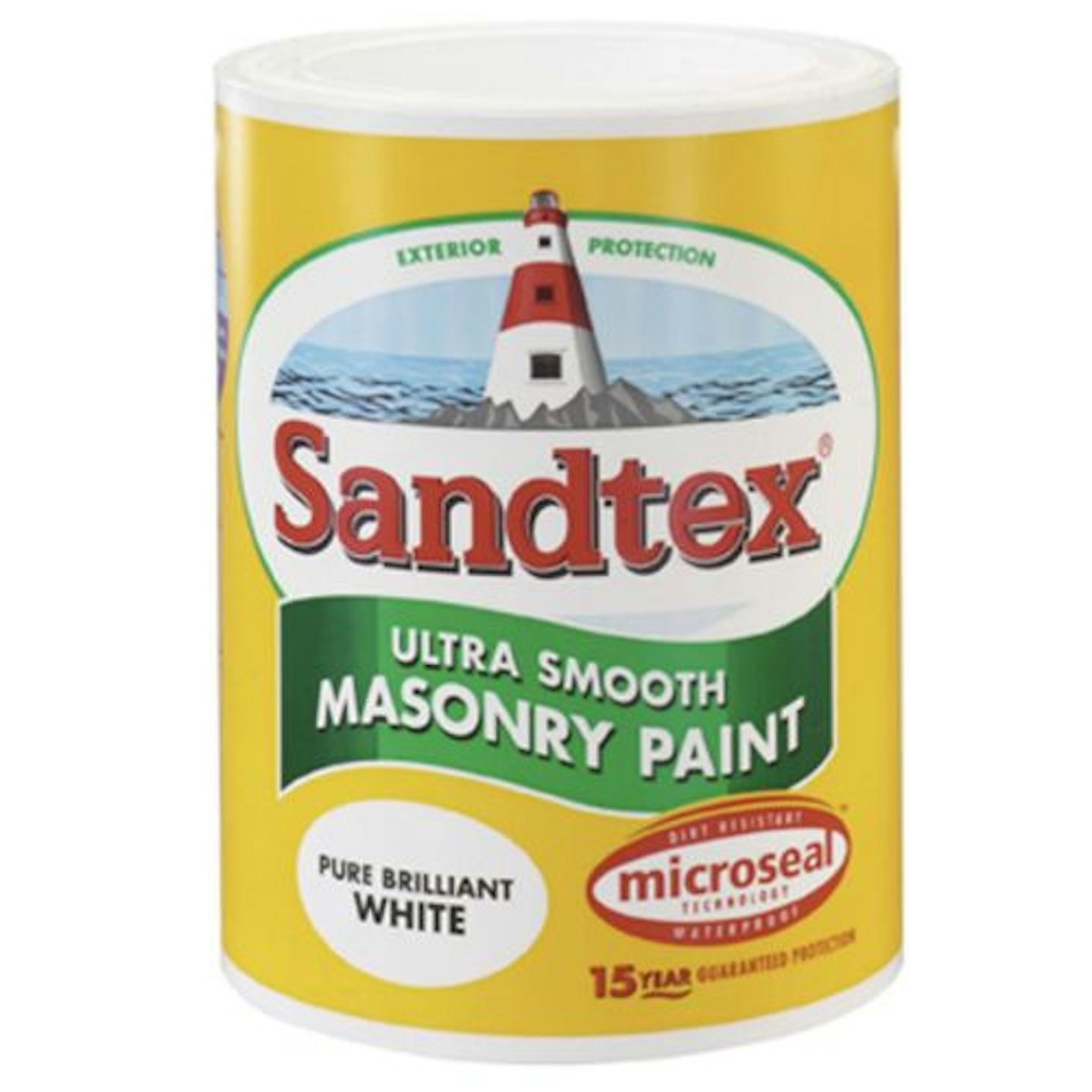
www.diy.com
It is generally recommended to use a primer for extra durability. But with this Sandtex Ultra Smooth Brilliant White Masonry Paint, you get the perfect base coat and coverage in one. Apply with a brush or roller on block, brick, concrete, pebble-dash, render and roughcast surfaces. Sandtex uses microseal technology so that surfaces are dirt-resistant, breathable and waterproof. Gives a durable and long-lasting finish that lasts up to 15 years.
Customer review: "As an outdoor paint novice, I wasn’t sure how this would last and how easy it would work on brick, breezeblocks and pebble dash, but worked brilliantly on all three. 5L goes quite a long way too."
Pros
- Value for money
- Weatherproof
- Excellent coverage
Cons
- None
| Size: | 5L, 10L, 2.5L |
| Coverage: | 16 sq m |
| Drying time: | 3-4 hours |
| Guarantee: | 15 years |
- Low solvent level
What to look for in the best outdoor wall paint
Use colour to put a spring in your step and protect your exterior surfaces from the harsh British weather with the best weather-resistant paint. But before we get into the products, there are a few factors that you need to know before you buy.
First, how much paint you'll need depends on the size of the area you're painting. You could require 2.5 litres or more. We recommend doing at least two coats of paint for longevity, so factor a second or third coat in. Coverage is listed in the product specification, stating how many square metres the quantity of paint will cover.
If you're on a budget, you need to scour for the best deals and figure out how much you can spare - or how much you're willing to spend. Good quality paint is not cheap. You should also pay attention to the guidance on how long the paint takes to dry and how well it covers - meaning how opaque or transparent the pigment is. Quality paint will not leave bristles behind like other cheaper versions, brands like Armstead, Dulux and Farrow and Ball are reliable and effective.
Regardless of whether you're outdoor surface, there are some common features to look for:
• Dirt and stain resistant
• Washable exterior paint - such as a gloss that you'd use on your window sills
• Algae and mould-resistant
• Fade-resistant
• Anti-scuff
• Breathable - so that moisture is expelled through brickwork
• Waterproof or water repellent
• Sun protecting
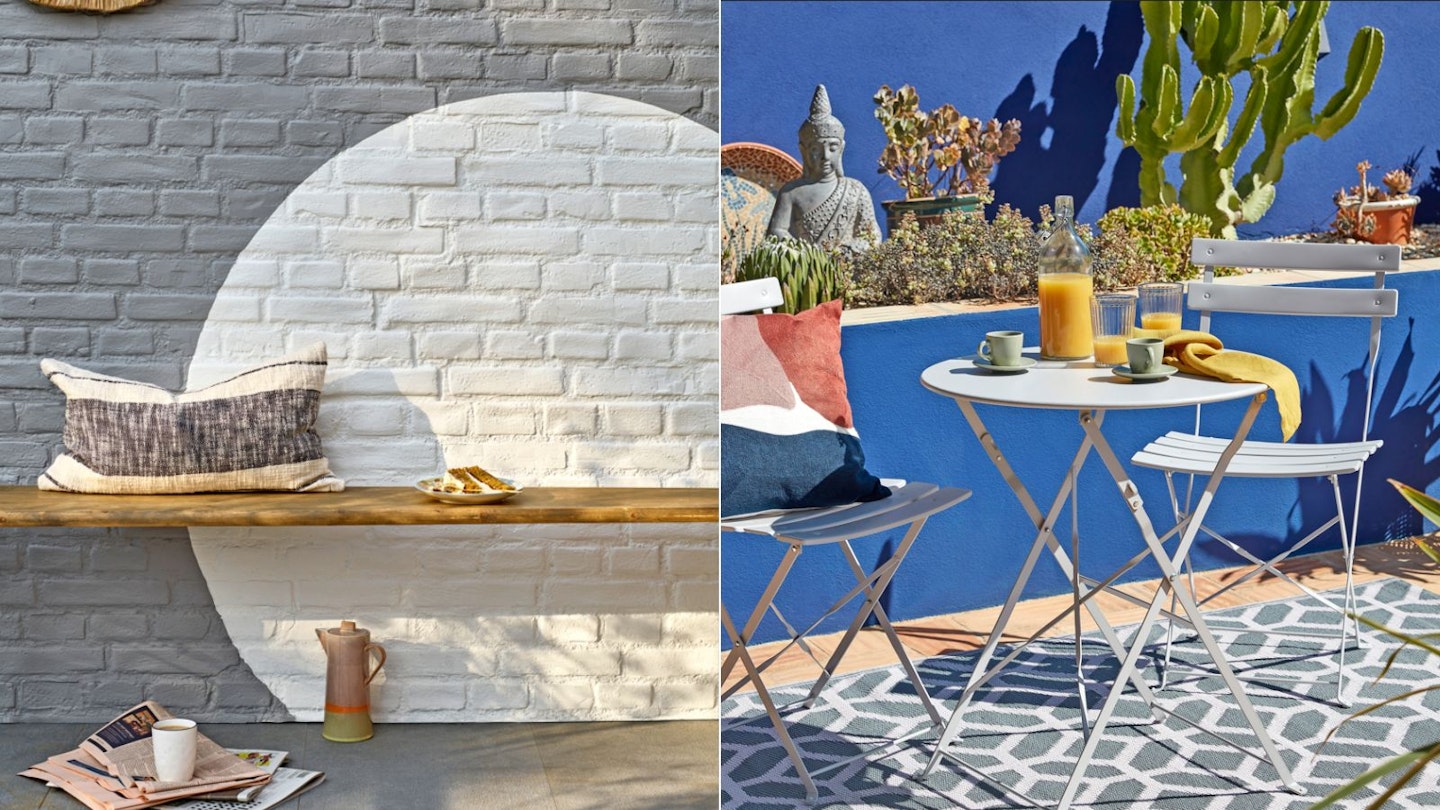
FAQs: Best outdoor wall paint
What are the different types of exterior paint?
There are three main types of exterior paint for use on wood, masonry and metal.
Wood paint, stain, varnish and oil can be used to protect wooden sheds, decking, fences, garden furniture and other wooden structures. Exterior wood paint, such as fence paint, will give the surface an opaque colour - there's an enormous range of shades to choose from and the paint is designed to be resistant to blistering and cracking. In addition, the paint will protect the wood from absorbing water. Exterior wood stain lets the grain of the wood show through while enriching the colour. A wood stain soaks into the wood and protects against the elements. An exterior wood oil can nourish wood that's lost its natural oils through exposure to harsh weather. Wood varnish enhances the full grain of the wood and provides a high level of protection.
Exterior masonry paint is suitable for all brick and stone surfaces, including pebbledash, cement, concrete, stone and stucco. Masonry paint protects and decorates exterior walls, such as the outside of your house, garden walls and garages. It's available in an enormous range of colours and in a smooth or textured finish.
Exterior metal paint offers weather protection and comes in a quick-drying water-based formula as well as traditional solvent-based paints. Metal paint provides weather protection for railings, gates, garden furniture, drainpipes and garden storage. You need to know what type of metal you are painting because there are products that are specifically designed for non-rusting metal surfaces such as aluminium, galvanised steel, copper and brass. There are all-in-one galvanised metal paints that have a built-in topcoat and don't need a primer. Also, there is paint that can be used on metal surfaces that rust. You will need to remove the rust before applying and you may need to apply a primer.
What are the different types of exterior paint finish?
Matte finish results in a flat, non-reflective finish that can help disguise uneven surfaces.
Satin finish offers a slight sheen. It's also known as a silk finish.
Gloss gives a highly reflective sheen and the most durable surface. It's a good option for doors that get frequent use as it is less prone to scuffing.
A smooth finish is exclusive to masonry paint and has a creamy consistency that makes it easy to apply.
A masonry paint with a textured finish provides hard-wearing coverage on uneven surfaces.
A hammered effect finish is only available for metal paints and can make a surface look distressed.
What paint preparation tools and accessories do I need?
No matter what you are painting outdoors, there are some fundamental points to consider, as Modern Gardens writer Jules Barton-Breck advises:
"The key to success is preparation so aim to spend just as much time prepping the surface as you do painting it. Check the weather forecast too, as for big makeovers such as walls and structures, you need a couple of dry and sunny, but not too hot, days to get it done. Stock up on the right tools as one brush doesn’t fit all, and make sure you buy the appropriate paint for the surface. After that, it’s time to let your imagination run free."
There are a few handy brushes, rollers, and cleaning and filling products that it's useful to have on standby in the shed for when a weekend project crops up.
Finally, having a protective kit will keep you and your clothes clean. Wear overalls, a mask, gloves and goggles and put a dust sheet down to protect pathways and decking. And, of course, a ladder and steps are a must-have for any high-wall painting - just remember to take care and be safe.
How do I paint masonry and brickwork?
Once you've prepped your masonry or brickwork, cover windowsills, doors and taps or electric sockets with plastic sheeting or masking tape, then lay heavy-duty dust sheets around the base of the walls.
If the walls are rendered, apply a watered-down coat of the masonry paint, approximately 10 parts paint to one part water, as a primer.
Once fully dry you can get painting. You should paint from top to bottom and work from right to left or left to right.
Start by painting around the edges of the walls and frames using a masonry brush. Then for speedy results, use a long pile roller with an extension pole. Buy two sleeves, one for the primer and one for the paint.
How do I dispose of my paint tins?
Paint tins cannot go into household waste, but you can take them to a recycling centre. Make sure any paint residue that's left in the tin is absolutely dry. If there's a little bit left at the bottom you can harden it with some cat litter or sand. Recycling centres will not accept liquid paint. Metal paint tins will be sent for recycling and plastic tins (which cannot be recycled) will be disposed of responsibly.
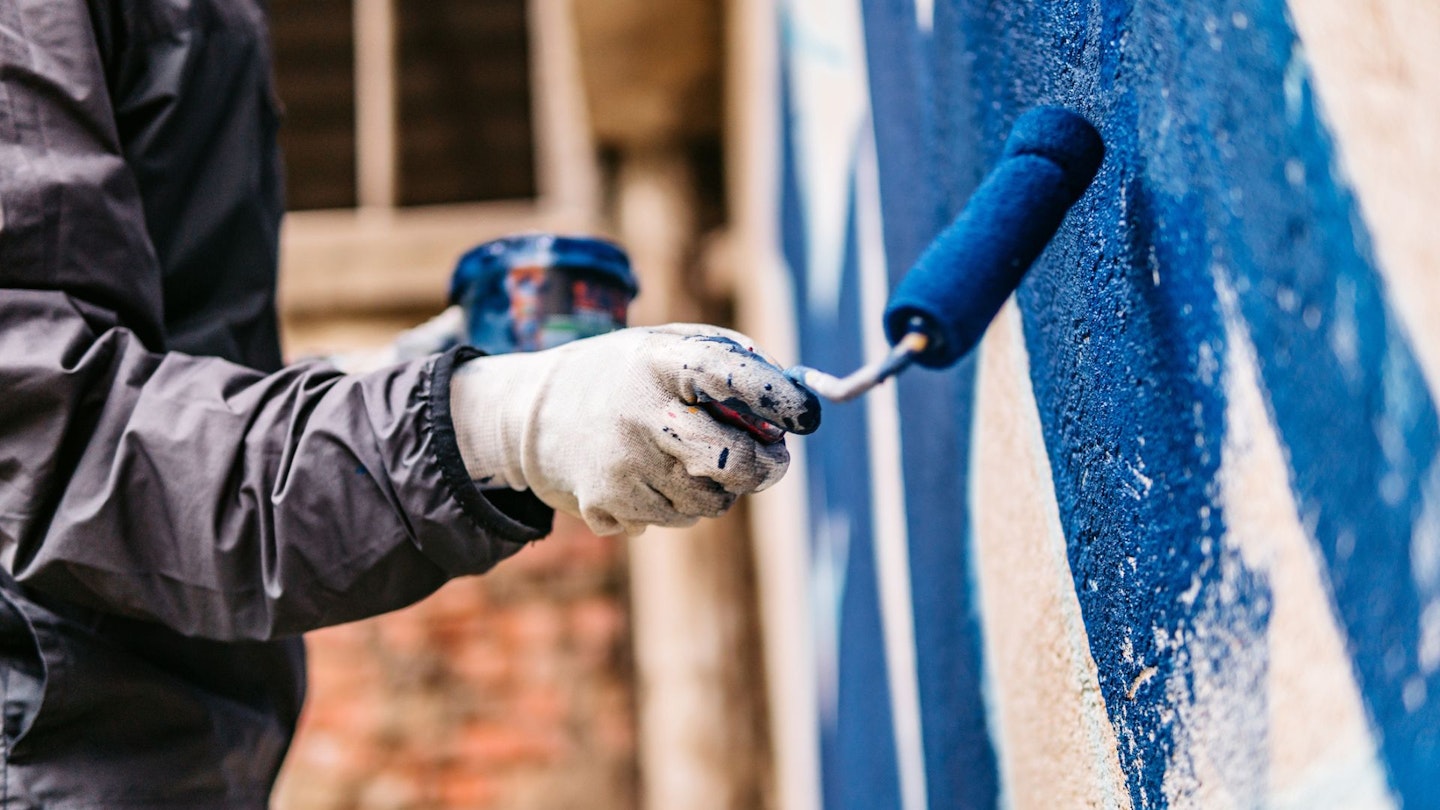
What to read next:
Cottagecore garden ideas for a self-sufficient outdoor space
Discover everything you need to know to make your outside space look fantastic, quickly and easily, with hundreds of simple ideas, designer tricks, affordable products and expert advice with a Modern Gardens Membership. Find out more about the benefits of being a Member now.
